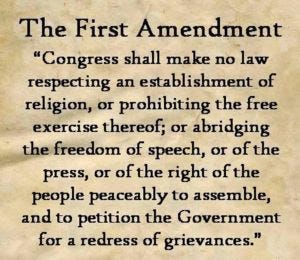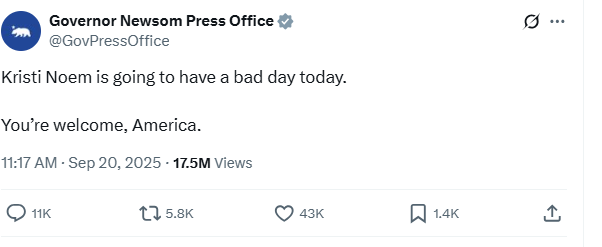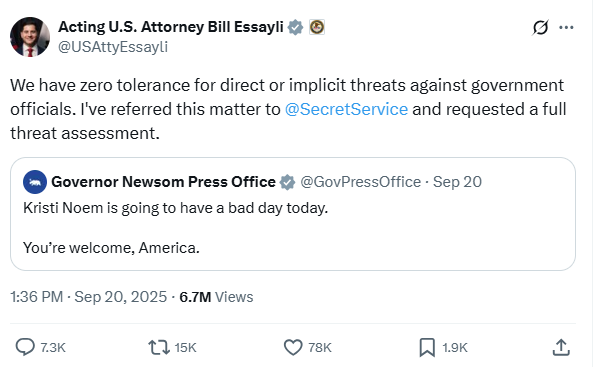There is lots of discussion about Free Speech in recent weeks—most of it based on very wrong assumptions about what is protected by the First Amendment. I therefore thought a primer on the First Amendment might make sense.
I will start with an example. Late last month, Governor Newsom’s press office sent out the following tweet:
The context of the post was that later that day Governor Newsom signed legislation designed to protect immigrant communities that was directed to the Department of Homeland Security. Nonetheless, conservative posters alleged that this was an illegal threat of violence, and Department of Homeland Security spokesperson Tricia McLaughlin criticized the press office’s post, saying, “This reads like a threat.” The U.S. Attorney deemed this a threat against Noem and referred the matter to the Secret Service:
So was this protected speech? Clearly yes. While there is no problem with the Secret Service doing an inquiry to make sure there there is no actual threat (they do this all the time), any criminal charges based on this tweet would be thrown out on a motion dismiss. While true threats of violence are not protected by the First Amendment, the standard for a true threat his very high and the Newsom tweet does not come even close to meeting this standard. Under Supreme Court authority a true threat includes only s “statements where the speaker means to communicate a serious expression of an intent to commit an act of unlawful violence to a particular individual or group of individuals.” Georgetown Law School has a useful summary of the law:
As the Supreme Court has explained, “[t]he ‘true’ in that term distinguishes” serious expressions of intent to harm “from jests, ‘hyperbole,’ or other statements that when taken in context do not convey a real possibility that violence will follow (say, ‘I am going to kill you for showing up late’).” Whether threatening language is a “true threat” therefore depends on context: is it specific, is it particularized to a person or an organization, is it made in a targeted way, how does the audience react? For example, the Supreme Court has held that a hyperbolic threat against the President made during a political debate was not a true threat because it was conditioned on an event unlikely to occur, and it was not received by the audience as serious. Similarly, the Supreme Court concluded that an ambiguous threat of violence made as part of a lengthy, “emotionally charged” political speech during a civil rights boycott was protected speech in the context in which it was made.
Under this test, the Newsom press office tweet is not a “true threat.” From the context, it is clear that it was not intended to be a threat, and the statement is too vague to be deemed a serious expression to commit unlawful violence.
Here is what else you need to know about the First Amendment. First, it only applies to government action. Your private employer fires you because you are a Democrat? Too bad, not protected by the First Amendment. (A government employee, on the other hand, would be protected). Your university suspends you for what they deem hate speech? Unless you are at a state university, too bad, not protected by the First Amendment. A social media site removes a post or terminates your account altogether because they don’t like the content? Too bad, not protected by the First Amendment. Tens of thousands of posters on twitter or X decide you are an evil person and flood your account with hateful messages? Again, too bad, not protected by the First Amendment.
Second, there is a caveat to this first principle. While wholly private retribution for speech is not protected by the First Amendment, if the government uses its coercive power to get private institutions to punish you, there is a First Amendment violation. The Supreme Court made this clear in a 2024 unanimous decision authored by Justice Sotomayor. In that case, a New York regulator allegedly pressured banks and insurance companies to stop doing business with the National Rifle Association. While the Court said that there is no problem with government officials using their own free speech to encourage private institutions to punish speech, it violates the First Amendment if they take one step further and threaten to take action against the private institutions that don’t take action.
As I discussed in a previous post, this principle came into play when FCC Chairman Brendan Carr threatened Disney, ABC and the ABC station owners with adverse action if they didn’t remove Jimmy Kimmel from the air. He said, “look, we can do this the easy way or the hard way,” and “These companies can find ways to change conduct and take action, frankly, on Kimmel, or there’s going to be additional work for the FCC ahead.”
A clear violation of the First Amendment under the NRA decision.
Third, with few exceptions, hateful, inflammatory and inflammatory speech is protected by the First Amendment. Comments like “I hate white people”, “and Send them back to the hellish countries in Europe where they came from,” are protected by the First Amendment. The exceptions to this principle are very narrow. Even incitement to break the law can be protected unless it is “directed to inciting or producing imminent lawless action and is likely to incite or produce such action.”
For example, the Supreme Court held in 1969 that KKK members who stated that here “might have to be some revenge taken” against government officials could not be subject to criminal prosecution. That same year, the Court said that the First Amendment protected the speech of a draftee who said [i]f they ever make me carry a rifle the first man I want to get in my sights is L. B. J.” Incitement crosses the line only crosses the line if the speaker is inciting immediate unlawful action—such as inciting the crowd to attack counter-demonstrators or the police.
This principle was recently put in play after the murder of Charlie Kirk, with member of the Trump Administration blaming “the left” for inciting his death by their strongly word criticisms of Kirk. Trump released a video in which he said, “For years, those on the radical left have compared wonderful Americans like Charlie to Nazis and the world’s worst mass murderers and criminals,” and “This kind of rhetoric is directly responsible for the terrorism that we’re seeing in our country today, and it must stop right now.
More recently, Stephen Miller has asserted that there is an organized and illegal effort to hamper immigration enforcement. “If you can’t see that since we’ve taken office, there’s been an organized, systemetized campaign to delegitimatize, dehumanize, threaten, impede, obstruct, and physically assault ICE officers in their duties, then I can’t persuade you of it, because you’re choosing not to see what’s right in front of your face!”
So what speech that Miller and Trump criticize is protected by the First Amendment? Almost all of it. Calling someone a Nazi, authoritarian or fascist , or calling ICE the Gestapo, may indeed have the aim of delegitimatizing or dehumanizing members of the Trump Administration or ICE, but it is nonetheless protected speech. Only incitement to commit an imminent unlawful act is not.
A few final points. The First Amendment is designed to provide quite broad protection of speech. The test of a principled position of free speech is if you insist on protecting the speech of political enemies. Sadly, on this score, we all fail. We find it hard to protect the speech of those we despise. We need to do better. If a David Goldberger, a Jewish lawyer can defend the rights of a neo-Nazi group to march in Skokie, we can do the same today.
But just because the First Amendment protects our own speech, it does not mean that we should show no constraint. In recent years, there has been an unfortunate pattern of organized social media campaigns that dox people who have said or done stupid things and then flooding their employer with messages demanding that the person be fired. The left used this tactic for many years, and in the aftermath of the Kirk murder are now on the receiving end of these social media mob attacks. This is protected First Amendment activities, but it is also deeply destructive and often quite unfair. We all say and do stupid and hateful things in our lives, and ought to show more grace when others do so.





Excellent summary. I'd also note that flag burning is generally considered protected speech. Most of the world admires this as a demonstration of America's commitment to the principles of free speech. Trump is trying to make it illegal.